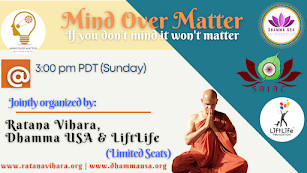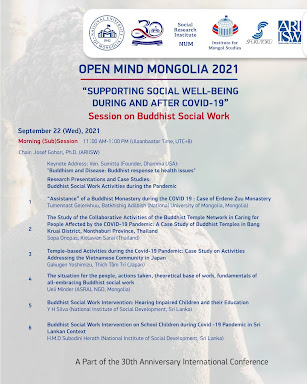Toronto Buddha Vihara - Children Day Uposatha Program - Eight Precepts & Buddha Vandana
Audience: Children with the age group of 6+ (with special attention to the Sri Lankan-Canadian children)
Medium: English
Conducted by: Ven. Dr. Nivitigala Sumitta (Bhante Sumitta)
Date: May 26, (Sunday) 2024
Time: 8:00 pm - 1:15 pm
Toronto Maha Vihara
Toronto Mahavihara Society
4698 Kingston Road
Scarborough, Ontario
M1E 2P9, Canada
VANDANĀ - Homage

Namo tassa bhagavato arahato sammā sambuddhassa
Namo tassa bhagavato arahato sammā sambuddhassa
Namo tassa bhagavato arahato sammā sambuddhassa
Homage to Him, the Blessed One, the Exalted One, the Fully
Enlightened One!
TI-SARAṆA - Three Refuges
Buddhaṃ saraṇaṃ gacchāmi
Dhammaṃ saraṇaṃ gacchāmi
Saṅghaṃ saraṇaṃ gacchāmi
Dutiyampi buddhaṃ saraṇaṃ gacchāmi
Dutiyampi dhammaṃ saraṇaṃ gacchāmi
Dutiyampi saṅghaṃ saraṇaṃ gacchāmi
Tatiyampi buddhaṃ saraṇaṃ gacchāmi
Tatiyampi dhammaṃ saraṇaṃ gacchāmi
Tatiyampi saṅghaṃ saraṇaṃ gacchāmi
I go to the Buddha as my refuge.
I go to the Dhamma as my refuge.
I go to the Sangha as my refuge.
For the second time, I go to the Buddha as my refuge.
For the second time, I go to the Dhamma as my refuge.
For the second time, I go to the Saṅgha as my refuge.
For the third time, I go to the Buddha as my refuge.
For the third time, I go to the Dhamma as my refuge.
For the third time, I go to the Sangha as my refuge.
Aṭṭha SĪLA - Eight Precepts
Pānātipātā veramaṇi sikkhā padaṃ samādiyāmi
Adinnādānā veramaṇi sikkhā padaṃ samādiyāmi
Abrahmacariyā veramaṇi sikkhā padaṃ samādiyāmi
Musāvādā veramaṇi sikkhā padaṃ samādiyāmi
Surā meraya majja pamādaṭṭhānā veramaṇi sikkhā padaṃ
samādiyāmi
Vikālabhojanā veramanī sikkhāpadaṃ samādiyāmi
Nacca-gīta-vādita-visūka dassana - mālā - gandha - vilepana - dhāraṇa - maṇḍaṇa - vibhūsanaṭṭhānā veramaṇī sikkhāpadaṃ samādiyāmi.
Uccāsayana - mahāsayanā veramaṇī sikkhāpadaṃ samādiyāmi.
Aṭṭha SĪLA - Eight Precepts
I undertake to observe the precept to abstain from killing living beings.
I undertake to observe the precept to abstain from taking things not given.
I undertake to observe the precept to abstain from sexual indulgence.
I undertake to observe the precept to abstain from false speech.
I undertake to observe the precept to abstain from distilled and fermented
liquor (drinks and drugs) that causes intoxication or heedlessness.
I undertake to observe the precept to abstain from taking food in inappropriate times.
I undertake to observe the precept to abstain from dancing, singing, music and unseemly shows; from the use of garlands, perfumes and unguents; from things that tend to beautify and adorn (the person).
I undertake to observe the precept to abstain from (using) high and luxurious seats.
BUDDHA VANDANĀ - Homage to the Buddha
Iti’pi so bhagavā, arahaṃ,
Sammā sambuddho,
Vijjā caraṇa sampanno,
Sugato, lokavidū,
Anuttaro purisa damma sārathī,
Satthā deva manussānaṃ,
Buddho, bhagavā’ti.
Such indeed is the Blessed One, exalted, omniscient, endowed with knowledge and virtues. Well-gone, Knower of the worlds, an Incomparable Charioteer for the training of individuals.Teacher of gods and men, Enlightened and Holy.
DHAMMA VANDANĀ - Homage to the Dhamma
Svākkhāto bhagavatā dhammo
Sandiṭṭhiko akāliko
Ehi-passiko opanayiko
Paccattaṃ veditabbo viññūhi’ti.
Well expounded is the Dhamma by the Blessed One,
visible here and now; not delayed in time,
inviting one to come and see; onward leading to Nibbana
to be attained by the wise, each for himself.
SAṄGHA VANDANĀ - Homage to the Saṅgha
Supaṭipanno bhagavato sāvaka saṅgho
Uju paṭipanno bhagavato sāvaka saṅgho
Ñāya paṭipanno bhagavato sāvaka saṅgho
Sāmīci paṭipanno bhagavato sāvaka saṅgho
Yadidaṃ cattāri purisa yugāni aṭṭha purisa puggalā
Esa bhagavato sāvaka saṅgho
Āhuneyyo pāhuneyyo
Dakkhiṇeyyo añjali karaṇīyo
Anuttaraṃ puññakkhettaṃ lokassā’ti.
Of good conduct is the Order of the Disciples of the Blessed One.
Of upright conduct is the Order of the Disciples of the Blessed One.
Of wise conduct is the Order of the Disciples of the Blessed One.
Of dutiful conduct is the Order of the Disciples of the Blessed One.
That is to say: the Four Pairs of Persons, the Eight Kinds of
Individuals, this community (Saṅgha) of the Blessed One;s disciples
is worthy of gifts, is worthy of hospitality,
is worthy of offerings, is worthy of reverential salutation,
is an incomparable field of merit for the world.
Saccakiriya - Asservation:
Etena sacca vajjena sotthi me /te hotu sabbadā
Etena sacca vajjena sotthi me/te hotu sabbadā
Etena sacca vajjena sotthi me/te hotu sabbadā
By the power of this truth, may all good be with me / you forever!
By the power of this truth, may all good be with me / you forever!
By the power of this truth, may all good be with me / you forever!
Note: in the asservation the Pali word 'me' is used to bless oneself while 'te' is used to bless others.
CETIYA VANDANĀ - Salutation to the Shrine
Vandāmi cetiyaṃ sabbaṃ
Sabba ṭhāne supatiṭṭhitaṃ
Sārīrika dhātu mahā bodhiṃ
Buddha rūpaṃ sakalaṃ sadā
I salute every cetiya (pagoda),
that may stand in any place,
the bodily relics, the Great Bodhi,
and all images of the Buddha.
BODHI VANDANĀ - Salutation to the Bodhi Tree
Yassa mūle nisinno’va - Sabbāri vijayaṃ akā
Patto sabbaññutaṃ satthā - Vande taṃ bodhi-pādapaṃ
Seated at whose base, the Teacher overcame all foes,
attaining Omniscience, that very Bodhi tree do I venerate.
Ime ete mahā-bodhi - Lokanāthena pūjitā
Ahampi te namassāmi - Bodhi-rājā namatthu te
This great tree of Enlightenment, reverenced by the Lord of the world, I too shall salute you! May there be homage to you, O royal Bodhi!
DῙPA PŪJĀ - Offering of Light
Ghana sārappa dittena – Dīpena tamadhaṃsinā
Tilokadipaṃ sambuddhaṃ – pūjayāmi tamonudaṃ
With lights brightly shining,
Abolishing this gloom,
I adore the Enlightened One,
Who dispels the darkness (of ignorance).
DHŪPA PŪJĀ - Offering of Incense
Sugandhikāya vadanaṃ – Ananta guṇa gandhinā
Sugandhinā’haṃ gandhena - Pujayāmi tathāgataṃ
With perfumed incense,
Made from fragrant substances,
I honor the Exalted One, worthy of respect,
Who dispels the darkness (of ignorance).
PUPPHA PŪJĀ - Offering of Flowers - 1
Vanna gandha gunopetaṃ – Etaṃ kusuma santatiṃ
Pūjāymi munindassa – Sirī pāda saroruhe
This mass of flowers - Fresh hued, fragrant and choice,
I offer at the sacred lotus - Like feet of the noble sage.
PUPPHA PŪJĀ - Offering of flowers – 2
Pūjemi Buddhaṃ kusumena nena
Puññena etena labhāmi mokkhaṃ
Pupphaṃ milāyāti yathā idaṃ me
Kāyo tathā yāti vināsa bhāvaṃ
I offer thee, Lord Buddha, these flowers - May this virtue aid in my emancipation. Our bodies undergo decay - Even as these flowers must fade.
UDAKA PŪJĀ - Offering of Water
Adhivāsetu no bhante – Pāniyaṃ parikappitaṃ
Anukampaṃ upādāya – Patiganhātu muttama
O Lord! The Blessed One, May this water
Be kindly accepted by you, Out of great compassion for us.
BHESAJJA PŪJĀ - Offering of Medicinal Drinks
Adhivāsetu no bhante – Gilāna paccayaṃ imaṃ
Anukampaṃ upādāya – Patiganhātu muttama
O Lord! The Blessed One, Please accept these medicinal drinks
As an offering to thee, Out of great compassion for us.
ĀHĀRA PŪJĀ - Offering of Food
Adhivāsetu no bhante – Bhojanaṃ parikappitaṃ
Anukampaṃ upādāya – Patiganhātu muttama
O Lord! The Blessed One, May this food
Be kindly accepted by you, Out of great compassion for us.
SABBA PŪJĀ - Offering of All the Offerings
Adhivāsetu no bhante – Sabbaṃ saddhāya pujitaṃ
Anukampaṃ upādāya – Patiganhātu muttama
O Lord! The Blessed One, Please accept all these offerings
Piously offered to you, Out of great compassion for us.
KHAMĀYĀCANĀ - Forgiveness of Shortcomings
Kāyena vācā cittena - Pamādena mayā kataṃ
Accayaṃ khama me bhante – Bhūri pañña tathāgata
If by deeds, speech or thought heedlessly, I have done anything wrong, forgive me O Master! - O Teacher, Most Wise!
Kāyena vācā cittena - Pamādena mayā kataṃ
Accayaṃ khama me dhamma – Sandiṭṭhika akālika
If by deeds, speech or thought heedlessly, I have done anything wrong, forgive me O Doctrine! Of which the beneficial result would be visible here and now, and the beneficial effects would not be delayed!
Kāyena vācā cittena - Pamādena mayā kataṃ
Accayaṃ khama me saṅgha – Supaṭipanna anuttara
If by deeds, speech or thought heedlessly, I have done anything wrong, forgive me O Saṅgha! Who is of good conduct, and incomparable.
ANUMODANĀ 1 - Transferring Merits to Devas and Other Beings
Ettāvatā ca amhehi – Sambhataṃ puñña sampadaṃ
Sabbe devā anumodantu – Sabba sampatti siddhiyā
May all the celestial beings share this merit, which we have thus acquired! May it contribute greatly to their happiness!
Ettavatā ca amhehi – Sambhataṃ puñña sampadaṃ
Sabbe bhūtā anumodantu – Sabba sampatti siddhiyā
May all the spirit beings share this merit, which we have thus acquired! May it contribute greatly to their happiness!
Ettavatā ca amhehi – Sambhataṃ puñña sampadaṃ
Sabbe sattā anumodantu – Sabba sampatti siddhiyā
May all the other beings share this merit, which we have thus acquired! May it contribute greatly to their happiness!
Ākāsaṭṭhā ca bhummaṭṭhā
Devā nāgā mahiddhikā
Puññaṃ taṃ anumoditvā
Ciraṃ rakkhantu lokasasanaṃ
May all beings inhabiting space and earth, Devas and Nāgās of mighty power, share this merit and may they long protect the dispensation!
Ākāsaṭṭhā ca bhummaṭṭhā
Devā nāgā mahiddhikā
Puññaṃ taṃ anumoditvā
Ciraṃ rakkhantu dhamma desanaṃ
May all beings inhabiting space and earth, Devas and Nagas of mighty power, share this merit and may they long protect the dispensation!
Ākāsaṭṭhā ca bhummaṭṭhā
Devā nāgā mahiddhikā
Puññaṃ taṃ anumoditvā
Ciraṃ rakkhantu maṃ paraṃ/ tvaṃ sadā.
May all beings inhabiting space and earth, Devas and Nagas of mighty power, share this merit and may they long protect the dispensation!
ANUMODANĀ 2 - Transferring Merits to the Departed Relatives
Idaṃ me ñātinaṃ hotu – Sukhitā hontu ñātayo.
Idaṃ me ñātinaṃ hotu – Sukhitā hontu ñātayo.
Idaṃ me ñātinaṃ hotu – Sukhitā hontu ñātayo.
Let this (merit) accrue to our relatives, and may they be well and happy!
SUHAMITTA PATTHANĀ – Aspiration for Spiritual Friends
Iminā puñña kammena – Mā me bāla samāgamo
Sataṃ samāgamo hotu – Yāva nibbāna pattiyā.
By the grace of this merit that I have acquired, May I never follow the evil friends; But only the good and spiritual friends until I attain the final goal-Nibbana.
NIBBĀNA PATTHANĀ – Aspiration for Nibbana
Idaṃ me puññaṃ – Āsavakkhayā vahaṃ hotu.
Idaṃ me puññaṃ – Āsavakkhayā vahaṃ hotu.
Idaṃ me puññaṃ – Āsavakkhayā vahaṃ hotu.
May this merit lead me to the cessation of all defilements!
sabba dukkhā pamuñcatu
sabba bhayā pamuñcatu
sabba rogā pamuñcatu
May you be delivered from all sufferings!
May you be delivered from all fears!
May you be delivered from all diseases!
Please Chant this prior to the chanting of the Protective Sutta or any other Sutta:
DEVĀRADHANĀ - Invocation to the Devas
Samantā cakkavālesu - Atrāgacchantu devatā
Saddhammaṃ munirājassa - Sunantu saggamokkhadaṃ
Parittassavanakālo ayaṃ bhadantā
Parittassavanakālo ayaṃ bhadantā
Parittassavanakālo ayaṃ bhadantā
In the universe in their entirety, let the deities come here,
The good doctrine of the king of sages which gives heaven and release.
This is the time to listen to the protective discourses.
This is the time to listen to the protective discourses.
This is the time to listen to the protective discourses.
Please Chant this after the chanting of the Sutta:
Saccakiriya - Asservation:
Etena sacca vajjena sotthi me /te hotu sabbadā
Etena sacca vajjena sotthi me/te hotu sabbadā
Etena sacca vajjena sotthi me/te hotu sabbadā
By the power of this truth, may all good be with me / you forever!
By the power of this truth, may all good be with me / you forever!
By the power of this truth, may all good be with me / you forever!
Note: in the asservation the Pali word 'me' is used to bless oneself while 'te' is used to bless others.
Sabbītiyo vivajjantu, sabbarogo vinassatu, mā te* bhavatvantarayo sukhī dīghayukho bhava
May all misfortunes be avoided, may all sickness be healed, may there be no dangers to you, may you live long and happily.
Bhavatu sabba maṅgalaṃ - rakkhantu sabba devatā sabba Buddhānu bhāvena - sadā sotthi bhavantu te*
May all blessings be with you. May all devas protect you. By the power of all the Buddhas, may you be well and happy.
Bhavatu sabba maṅgalaṃ - rakkhantu sabba devatā sabba Dhammānu bhāvena - sadā sotthi bhavantu te*
May all blessings be with you. May all devas protect you. By the power of all the Dhamma, may you be well and happy.
Bhavatu sabba maṅgalaṃ - rakkhantu sabba devatā sabba Saṅghānu bhāvena - sadā sotthi bhavantu te*
May all blessings be with you. May all devas protect you. By the power of all the Sangha, may you be well and happy.
Nakkhatta yakkha bhūtanaṃ papaggaha nivaraṇa parittassānu bhāvena, hantu tesaṃ upaddave
By the power of this protection, may you be free from all dangers arising from malign influences of the planets, demons and powerful spirits. May your misfortunes vanish.
Ākāsaṭṭhā ca bhummaṭṭhā
Devā nāgā mahiddhikā
Puññaṃ taṃ anumoditvā
Ciraṃ rakkhantu lokasasanaṃ
May all beings inhabiting space and earth, Devas and Nāgās of mighty power, share this merit and may they long protect the dispensation!
Ākāsaṭṭhā ca bhummaṭṭhā
Devā nāgā mahiddhikā
Puññaṃ taṃ anumoditvā
Ciraṃ rakkhantu dhamma desanaṃ
May all beings inhabiting space and earth, Devas and Nagas of mighty power, share this merit and may they long protect the dispensation!
Ākāsaṭṭhā ca bhummaṭṭhā
Devā nāgā mahiddhikā
Puññaṃ taṃ anumoditvā
Ciraṃ rakkhantu maṃ paraṃ/ tvaṃ sadā.
May all beings inhabiting space and earth, Devas and Nagas of mighty power, share this merit and may they long protect the dispensation!
ANUMODANĀ 2 - Transferring Merits to the Departed Relatives
Idaṃ me ñātinaṃ hotu – Sukhitā hontu ñātayo.
Idaṃ me ñātinaṃ hotu – Sukhitā hontu ñātayo.
Idaṃ me ñātinaṃ hotu – Sukhitā hontu ñātayo.
Let this (merit) accrue to our relatives, and may they be well and happy!
SUHAMITTA PATTHANĀ – Aspiration for Spiritual Friends
Iminā puñña kammena – Mā me bāla samāgamo
Sataṃ samāgamo hotu – Yāva nibbāna pattiyā.
By the grace of this merit that I have acquired, May I never follow the evil friends; But only the good and spiritual friends until I attain the final goal-Nibbana.
NIBBĀNA PATTHANĀ – Aspiration for Nibbana
Idaṃ me puññaṃ – Āsavakkhayā vahaṃ hotu.
Idaṃ me puññaṃ – Āsavakkhayā vahaṃ hotu.
Idaṃ me puññaṃ – Āsavakkhayā vahaṃ hotu.
May this merit lead me to the cessation of all defilements!
sabba dukkhā pamuñcatu
sabba bhayā pamuñcatu
sabba rogā pamuñcatu
May you be delivered from all sufferings!
May you be delivered from all fears!
May you be delivered from all diseases!
Sādhu! Sādhu!! Sādhu!!!









































%20(1).png)




